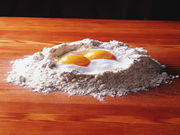On trace-back investigation, flour production facility ID’d as common point of contamination
WEDNESDAY, Nov. 22, 2017 (HealthDay News) — Raw flour can be a source of outbreak of Shiga toxin-producing Escherichia coli (STEC) infections, according to a study published in the Nov. 23 issue of the New England Journal of Medicine.
Samuel J. Crowe, Ph.D., M.P.H., from the U.S. Centers for Disease Control and Prevention in Atlanta, and colleagues examined an outbreak of STEC serogroup O121 and O26 infections linked to contaminated flour. Outbreak cases, defined as infection with an outbreak strain in which illness onset was between Dec. 21, 2015, and Sept. 5, 2016, were compared with non-STEC enteric illness cases, matched for age group, sex, and state of residence.
The researchers identified 56 cases in 24 states. In univariable models, infection was significantly associated with use of one brand of flour and with tasting unbaked homemade dough or batter (odds ratios, 21.04 and 36.02, respectively). The outbreak strains were isolated from flour samples and whole-genome sequencing showed that the isolates from clinical and food samples were closely related genetically. A common flour-production facility was identified on trace-back investigation.
“This investigation implicated raw flour as the source of an outbreak of STEC infections,” the authors write. “Although it is a low-moisture food, raw flour can be a vehicle for foodborne pathogens.”
Copyright © 2017 HealthDay. All rights reserved.








